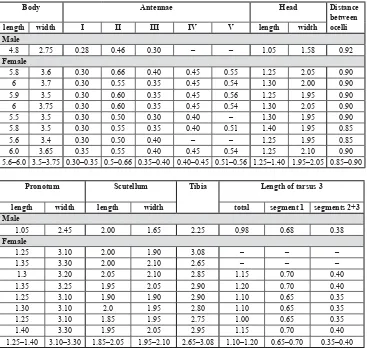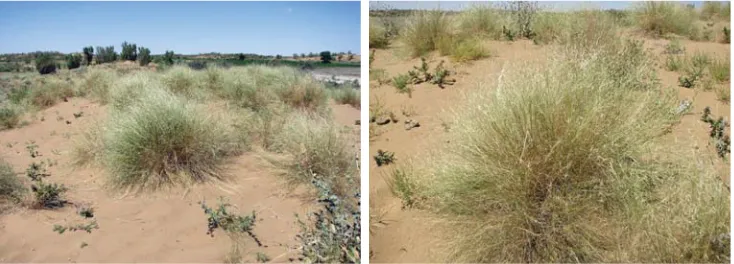Published 15.xii.2014 Volume 54(2), pp. 469–477 ISSN 0374-1036 http://zoobank.org/urn:lsid:zoobank.org:pub:DBA39829-1D67-470C-8302-350915E698A7
A new species of the genus
Menaccarus
from China
(Hemiptera: Heteroptera: Pentatomidae)
Zhao-Hui LUO1) & Nikolai N. VINOKUROV2)
1) Key Laboratory of Biogeography and Bioresource in Arid Land and Xinjiang Institute of Ecology
& Geography, China Academy of Sciences, 818, South Beijing Road, Urumchi, Xinjiang, 830011, P. R. China; e-mail: luozhaohui@ms.xjb.ac.cn
2) Institute for Biological Problems of Cryolithozone, Siberian Branch of the Russian Academy of Science,
Prospekt Lenina 41, Yakutsk 677980, Russia; e-mail: n_vinok@mail.ru
Abstract. The genus MenaccarusAmyot & Serville, 1843 is recorded for the ¿ rst time from China and represented by a new species, M. (Orocephalus) caii
sp. nov. The new species, collected in the Gurbantunggut Desert (Xinjiang), is similar to the Irano-Turanian M. (Orocephalus) deserticola Jakovlev, 1900 and it can be distinguished from the latter mainly by characters of the male genitalia.
Key words. Heteroptera, Pentatomidae, Menaccarus, new species, Xinjiang, China, Central Asia, Palaearctic Region
Introduction
The genus Menaccarus Amyot & Serville, 1843 includes 7 species belonging to three subgenera distributed in the arid regions of the Old World (RIDER 2006). The single member
of the nominotypical subgenus, M. (Menaccarus) piceus Amyot & Serville, 1843, occurs in the Afrotropical Region (Nigeria, Sudan, Yemen). The remaining 6 species are classi¿ ed into the subgenera Oploscelis Mulsant & Rey, 1852 (1 species) and Orocephalus Mulsant & Rey, 1866 (5 species), distributed in the Ancient Mediterranean Subregion of the Palaearctic Region. Three species are known from the territory of the former USSR, namely Menaccarus
(Oploscelis) arenicola (Scholtz, 1847), M. (Orocephalus) deserticola Jakovlev, 1900, and M.
(Orocephalus) divaricatus Jakovlev, 1877; these were redescribed and keyed by DERZHANSKY
(1994) and ISAKOV (2006). PUTHSKOV (1965) recorded the Mediterranean species M. (
Oroce-phalus) dornianus (Mulsant & Rey, 1866) from Middle Asia (Turkmenistan, Uzbekistan and Tajikistan) but DERZHANSKY (1994) claimed that it does not inhabit this territory.
VINOKUROV & LUO: A new Menaccarus from China (Pentatomidae)
470
Material and methods
Specimens were swept in 2011 from grasses in Gurbantunggut Desert during a study on the biodiversity of the true bugs in North-Western China initiated by the Xinjiang Institute of Ecology and Geography of the Chinese Academy of Sciences. Descriptions and ¿ gures of the male genitalia were prepared using a Nikon Eclipse 80i upright microscope and a Nikon DXM1200C digital camera. All measurements are in millimeters.
The following abbreviations are used in ¿ gures: a.th. — apical part of theca; b.th. — basal part of theca; g.s. — secondary gonopore; lam.m. – medial plate of aedeagus; l.vl. — ven-trolateral lobe of conjunctiva; ram.l. — lateral branch of vetnrolateral lobe of conjunctiva;
rɚɬ.v. – ventral branch of ventrolateral lobe of conjunctiva; s.l. — lateral sclerite of con-junctiva; tub.d. — dorsal tubercles of conjunctiva; ves. — vesica, t8 – tergit VIII, rc – rectum,
S7 – sternit VII, t – tergit VIII, X – segment X, vf8 – valvifers VIII, vf9 – valvifers IX (after: ISAKOV 2005, TSAI et al. 2011).
The holotype and one paratype are deposited in the collection of the Zoological Institute of the Russian Academy of Science, St. Petersburg (ZISP), the remaining paratypes in the collections of the Xinjiang Institute of Ecology and Geography, Xinjiang, Urumqi (XJIEG) and the China Agricultural University, Beijing (CAU).
The distribution of M. deserticola is mapped based on materials in the collection of ZISP kindly communicated by Dr. V. V. Derzhansky (Institute of Zoology, Academy of Sciences of Moldova, Kishinev).
Taxonomy
Menaccarus(Orocephalus)caiisp. nov.
(Figs 1, 2, 5í8, 17í19, 22)
Material examined. HOLOTYPE: , China, Xinjiang-Uyghur Autonomous Region: ‘Gurbantunggut Desert: Road
216 (44°47މN; 88°47މE), 460 m, 26.VI.2011, leg. N. Vinokurov’ (ZISP). PARATYPES: 7 , China, Xinjiang-Uyghur
Autonomous Region: ‘Gurbantunggut Desert: 25 km N of Fukang (44°27މN; 87°52މE), 25.VI.2011, leg. N. Vino-kurov’ (ZISP, XJIEG); 1 , China, Xinjiang-Uyghur Autonomous Region: ‘149tuan, 80 km N of Shihezi (44°46މN, 86°14މE), 290 m, 7.VII.2011, leg. N. Vinokurov’ (CAU).
Description.For measurements see the Table.
Male(Fig. 1). Body oval, À attened, 1.7 times as long as wide, dull sandy yellow, with rather dense brownish black and reddish punctation, without pubescence except for erect bristles on lateral margins of head and pronotum.
Figs 1–4. Habitus of Menaccarus spp. 1, 2 – M. caii sp. nov. (1 – male, 2 – female), 3 – M. divaricatus Jakovlev, 1877, 4 – M. deserticola Jakovlev, 1900 (3, 4 – after ISAKOV 2006).
weakly thickened apex; segment III thickened apically; segments IV and V lacking in studied specimens. Ventral part of head white, bucculae low. Labium yellowish white, reaching mid coxae, segment II slightly extends beyond posterior end of bucculae.
VINOKUROV & LUO: A new Menaccarus from China (Pentatomidae)
472
Figs 5–16. Male genitalia of Menaccarus spp. 5–8 – M. caii sp. nov., 9–12 – M. deserticola Jakovlev, 1900 (Bossaga, Turkmenistan), 13–16 – M. divaricatus Jakovlev, 1877 (Termez, Uzbekistan). (5–7, 9–11, 13–15 – left paramere in various positions, 8, 13, 16 – male genital capsule, dorsal view).
Figs 17–19. Aedeagus of Menaccarus caii sp. nov. (Gurbantunggut Desert) (17 – lateral view, 18 – frontal view, 19 – dorsal view). For abbreviations see Material and methods.
VINOKUROV & LUO: A new Menaccarus from China (Pentatomidae)
474
Abdomen pale yellow ventrally, weakly shining, connexivum not punctured.
Male genitalia. Posterolateral angles of genital segment produced into a pair of broadly spatulate processes, median process wide, with parallel sides (Fig. 8); body of paramere slender and straight, with hooked apex and a large, triangular lateral process with a sharp tip (Figs 5–7); medial plate of aedeagus partially sclerotized, provided with several minute sclerotized teeth at its apical and ventral portion; lateral lobes of conjunctiva sclerotized, provided with many denticles, dorsal tubercles of conjunctiva small, black (Figs 17–19).
Female(Fig. 2). Body larger, 1.6–1.7 times as long as wide, coloration as in male. Head
with reddish and dark brown punctures, longitudinal impression anteriad of ocelli deeper and shiny. Antennae brownish yellow; segment I white, segments II–V brown; segment II cylindrical, with thickened apex, covered with very long, erect setae, 2–3 times as long as diameter of segment; segment III thickened at apex, also with long erected setae; segments IV–V with short, white, thin semi-erect setae, adpressed laterally; segment IV conical, seg-ment V fusiform. Genital segseg-ments (Fig. 22): valvifers VIII large, length and width subequal, mesal margin straight, lateral margin weakly convex; lateral margin of valvifers IX arcuate; tergite VIII arcuately curved.
Differential diagnosis.Menaccarus caii sp. nov. is similar in habitus to the other members of the subgenus Orocephalus externally and can mainly be recognized by characteristics of the genitalia, as follows. Male: lateral projection on the body of paramere triangular with a sharp tip (Figs 5–7), lateroapical lobes of the genital capsule spatulate, medial process broad with parallel sides (Fig. 8); medial plates of aedeagus sclerotized apically and provided with
several minute denticles ventrobasally; lateral lobes of the conjunctiva also provided with several denticles, dorsal tubercles of conjunctiva small and black (Figs 17–19). Female: valvifers VIII large, its length and width almost equal, mesal margin straight, lateral margin weakly convex; lateral margin of valvifers IX arcuate; tergite VIII arcuately curved (Fig. 22).
The new species is similar to the Turanian M. (Orocephalus) deserticola in the connexivum lacking black punctures conÀ uent to black patches, but in the latter species the lateral process of the paramere is narrower and bent inwards in apical part (Figs 9–11), lateroapical lobes of the genital capsule are triangular with rounded apex, medial process is narrow (Fig. 12), medial plates of aedeagus are extensively sclerotized and provided with several denticles, lateral lobe of conjunctiva is also sclerotized and provided with denticles, and dorsal tubercles
Table 1. Measurements of Menaccarus caii sp. nov. (Gurbantunggut Desert).
Body Antennae Head Distance
between ocelli length width I II III IV V length width Male
4.8 2.75 0.28 0.46 0.30 – – 1.05 1.58 0.92
Female
5.8 3.6 0.30 0.66 0.40 0.45 0.55 1.25 2.05 0.90
6 3.7 0.30 0.55 0.35 0.45 0.54 1.30 2.00 0.90
5.9 3.5 0.30 0.60 0.35 0.45 0.56 1.25 1.95 0.90
6 3.75 0.30 0.60 0.35 0.45 0.54 1.30 2.05 0.90
5.5 3.5 0.30 0.50 0.30 0.40 – 1.30 1.95 0.90
5.8 3.5 0.30 0.55 0.35 0.40 0.51 1.40 1.95 0.85
5.6 3.4 0.30 0.50 0.40 – – 1.25 1.95 0.85
6.0 3.65 0.35 0.55 0.40 0.45 0.54 1.25 2.10 0.90
5.6–6.0 3.5–3.75 0.30–0.35 0.5–0.66 0.35–0.40 0.40–0.45 0.51–0.56 1.25–1.40 1.95–2.05 0.85–0.90
Pronotum Scutellum Tibia Length of tarsus 3
length width length width total segment 1 segments 2+3 Male
1.05 2.45 2.00 1.65 2.25 0,98 0.68 0.38
Female
1.25 3.10 2.00 1.90 3.08 – – –
1.35 3.30 2.00 2.10 2.65 – – –
1.3 3.20 2.05 2.10 2.85 1.15 0.70 0.40
1.35 3.25 1.95 2.05 2.90 1.20 0.70 0.40
1.25 3.10 1.90 1.90 2.90 1.10 0.65 0.35
1.30 3.10 2.0 1.95 2.80 1.10 0.65 0.35
1.25 3.10 1.85 1.95 2.75 1.00 0.65 0.35
1.40 3.30 1.95 2.05 2.95 1.15 0.70 0.40
VINOKUROV & LUO: A new Menaccarus from China (Pentatomidae)
476
Fig. 25. Distribution of Menaccarus deserticola Jakovlev, 1900 (green) and M. caii sp. nov. (red).
Figs 26–27. Biology of of Menaccarus caii sp. nov. 26 – habitat in the Gurbantunggut Desert (25 km N of Fukang); 27 – Aristida pennata Trin. – host plant of Menaccarus caii sp. nov.
of conjunctiva are small and weakly sclerotized (Figs 20, 21); in females the lateral margins of valvifers VIII and tergite VIII are more convex (Fig. 23).
Etymology. The species is named in honor of Chinese entomologist Professor Wanzhi Cai (China Agricultural University, Beijing) recognizing his contributions to the study of insects of Xinjiang.
Bionomics. Menaccarus caii sp. nov. is associated with Aristidapennata Trin. (Poaceae) (Figs 26, 27).
Distribution.Menaccarus caii sp. nov. is known from the central part of Xinjiang, the southern areas of the Gurbantunggut Desert (Fig. 25).
Discussion
So far the easternmost border of the area of Menaccarus (Orocephalus) was the Turanian Plane where this subgenus is represented by two species: M. divaricatus and M. deserticola
(DERZHANSKY 1994, ISAKOV 2005). The new species M. caii sp. nov. is an eastern vicariant of
the former two species distributed in Dzungaria (North-Western China), thus separated from the area of the above two species by about 1600 km (Fig. 17). The unexpected discovery of this new species extends the known range of the genus Menaccarus far away from Central Asia. We emphasize that the occurrence of M. (Oploscelis) arenicola, a species widely dis-tributed in the Western Palaearctic, Kazakhstan, south of West Siberia (Altay) and Middle Asia (Kyrgyzstan) (RIDER 2006, DERZHANSKY 1994), in Northern Xinjiang would also not
be unexpected. Targeted collecting in suitable habitats might result in discovery of further endemic Dzungarian species as well.
Acknowledgements
The authors are grateful to F. V. Konstantinov (St. Petersburg State University, Russia), V. V. Derzhansky (Kishinev, Moldova), D. A. Gapon (ZISP), P. Kment (National Museum, Prague, Czech Republic) for valuable advices, useful comments and copies of important literature. We are also grateful to Dávid Rédei (Nankai University, Tianjin, China) for correction of English translation of the manuscript. The research was supported by a Visiting Professorship for Senior International Scientists provided by the Chinese Academy of Sciences (No. 2010T2Z31) and partially by the Russian Fund for Basic Research, project No 13-04-00660-a.
References
DERZHANSKY V. V. 1994: Species of the genus Menaccarus in the fauna of the former USSR (Heteroptera: Pen-tatomidae). Zoosystematica Rossica3(2): 263–264.
ISAKOV Y. M. 2005: O shchitnikakh roda Menaccarus (Heteroptera, Pentatomidae) na territorii byvshego SSSR. Soobshchenie 1. Imago. [About pentatomid-genus Menaccarus (Heteroptera, Pentatomidae) on the territory of the former USSR. Communication 1. Imago]. Vestnik Zoologii 39(4): 15–27 (in Russian).
PUTSHKOV P. V. 1965: Shchitniki Sredney Azii (Hemiptera, Pentatomoidea). [Shield-bugs of Middle Asia (Hemip-tera, Pentatomoidea)]. Ylim, Frunze, 331 pp (in Russian).
RIDER D. A. 2006: Family Pentatomidae Leach, 1815. Pp. 233–402. In: AUKEMA B. & RIEGER CH. (eds.):
Cata-logue of the Heteroptera of the Palaearctic Region. Vol. 5. Pentatomomorpha II. The Netherlands Entomological Society, Amsterdam, xiii + 550 pp.
Acta Entomologica Musei Nationalis Pragae, 54(2), 2014

